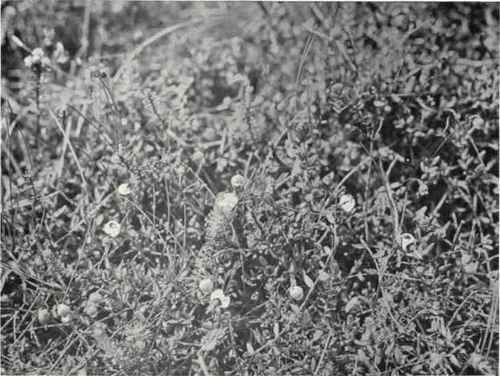Cranberry (Oxycoccus Palustris, Pers. = O. Quadripetala, Gilib.)
Description
This section is from the book "British Wild Flowers - In Their Natural Haunts Vol5-6", by A. R. Horwood. Also available from Amazon: A British Wild Flowers In Their Natural Haunts.
Cranberry (Oxycoccus Palustris, Pers. = O. Quadripetala, Gilib.)
Though an Arctic plant the Cranberry has not been found in any early deposits. At the present day it occurs in the North Temperate and Arctic Zones in Arctic Europe, but not in Turkey, in N. Asia, and America. It is local in Great Britain, found only in Somerset in the Peninsula province; the Isle of Wight, N. Hants, and Sussex in the Channel province; Surrey, S. Essex in the Thames province; E. Suffolk, Norfolk, Cambridge, Hunts in Anglia; but does not occur in Gloucs or Hereford in the Severn province; not in Radnor or Pembroke in S. Wales; and in N. Wales, not in Montgomery or Merioneth; in the Trent province, not in Leics; in the Mersey province, not in Mid Lancs; in the Humber province, not in S.E. Yorks; but throughout the Tyne and Lakes provinces, except in the Isle of Man; in the West Lowlands, not in Wigtown; in E. Lowlands, not in Peebles, Selkirk, Haddington, or Linlithgow; in the E. Highlands generally, except in N. Aberdeen and Elgin; in Dumbarton, Cantire, North Ebudes, and E. Ross. It ascends to 2700 ft. in the Highlands. It is native in Ireland.

Photo. Flatters & Garnett - Cranberry (Oxycoccus palustris, Pers. = O. quadripetala, Gilib.)
Cranberry is a true bog-loving plant, growing at high elevations in spongy peat-bogs where Sphagnum and other bog-mosses grow. It is associated with Grass of Parnassus, Sundew, Wild Rosemary, Bog Pimpernel, Bog Speedwell, Butterwort, Bladderwort, Bog Myrtle, Bog Asphodel, and many others.
The acid nature of the fruit is referred to in the first Greek name. The plant is a trailing evergreen, with a rooting angular stem, slender, and creeping. The leaves are egg-shaped, lance-shaped, coarsely-toothed, with turned-back margin, entire, and bluish-green below.
The flowers are pink with a wheel-shaped corolla, and the flower-stalks are I-flowered, terminal, slender, long, and simple. The segments of the red corolla are turned back.
The stem is 3 in. high at most. Flowering is in full swing in June, right up to August. The flower is in bloom for nearly three weeks.
It is a shrub, perennial, propagated by layers, and worth cultivating for the fruit.
The flowers are as in the Whortleberry, but the corolla is wheel-shaped, and the anthers, which are broad, are awnless. The stamens form a tube and are projecting, the anthers being yellow, and the filaments purple and pubescent. The corolla lobes are narrow and linear. The style is filiform, the stigma blunt. The stamens on the outside are closely ranked, and insect visitors must penetrate to the stigma between the anthers. The berry is edible and red when ripe, and is eaten and dispersed in this way.
The Cranberry is a peat-loving plant which grows only in a humus or peaty soil, and is confined to certain woods and hilly moors.
A beetle, Chailocnema sahlbergi, two moths, Manchester Treble-bar (Carsia imbutata), Mesotype virgata, are found upon it.
Oxycoccus, Cordus, is from the Greek oxys, sharp, coccus, fruit or berry, because of its acridity, and Cranberry is given because it is ripe when the cranes (as they call herons) appear. The second Latin name refers to the 4 petals.
The names by which it is known include Bog-berry, Corn-berries, Cramberries, Cranberry, Craneberry, Cranna-berries, Craw-berry, Crawnberries, Crone, Crones, Fenberry, Fen-grapes, Marsh Berries, Marsh Worts, Moonog, Moor-berries, Moss-berries, Moss Millions, etc.
The berries are sharp, and used in tarts and preserves. This rare heath is capable of cultivation.
Essential Specific Characters: 191. Oxycoccus quadripetala, Gilib. - Shrub, stem prostrate, filiform, rooting, leaves small, glaucous below, margins revolute, evergreen, flowers rose, terminal, corolla rotate, segments reflexed, berries scarlet.
Continue to:


